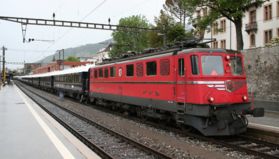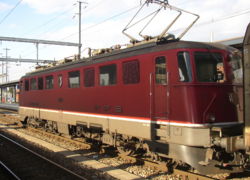SBB-CFF-FFS Ae 6/6
| Ae 6/6 11419 "Appenzell Innerrhoden" in Sierre | |
| Production and service data | |
|---|---|
| Build date | 1952, 1955–1966 |
| Road numbers | 11401 – 11520 |
| Road numbers (UIC) | Ae 610 000 – Ae 610 119 |
| Production | 120 |
| Still in use (2005) | 110 |
| Services | Passenger and freight trains; Today only freight |
| Maintenance facility | Bellinzona |
| End of operation | due to old age since 2002 |
| Technical data | |
| Vehicle type | Electric locomotive |
| Builder | SLM Winterthur BBC Baden MFO Zürich |
| Wheel arrangement | Co'Co' |
| Top speed | 125 km/h Today: 120 km/h |
| Motive power | 4300 kW |
| Continuous traction | 221 kN |
| Maximum traction | 392 kN |
| Performance on inclines | 650 tons train on a 26 ‰ gradient at 75 km/h |
| Size and weight | |
| Length over buffers | 18'400 mm |
| Width | 2970 mm |
| Height | 4500 mm |
| Weight | 120 t Prototypes: 124 t |
| Other | |
| Special characteristics | 2 prototypes differ in some areas |
| Predecessor | Ae 4/6 |
| Successor | Re 620 |
The Ae 6/6 is a heavy electric locomotive used by the SBB-CFF-FFS. It is sometimes also referred to as canton locomotive ("Kantonslokomotive"), because the first 25 locomotives carried coats of arms of all Swiss cantons, chrome ornaments on their sides and front, and the Swiss coat of arms on the front, between chrome ornaments. These adornments made them internationally famous. The other 95 locomotives of the series production got coats of arms of capitals of Swiss cantons or other important cities, but no chrome ornaments any more. The baptisms were held as ceremonies in the respective cities.
Due to being originally designed for heavy services on the Gotthard route, as many Swiss locomotives were, the Ae 6/6 was one of the classic Gotthard locomotives.
Originally, all locomotives had a SBB-CFF-FFS green livery. Nowadays about half are painted red.
Contents
History
Before the advent of the Ae 6/6, trains on the Gotthard route were pulled mainly by Ae 4/6, Ae 4/7 and Be 6/8 ("crocodile"), which were comparably weak by nowadays standards. This led to many trains needing bank engines on the Gotthard slopes, and adding them was a tedious, uneconomical and impractical procedure.
Demands on the Ae 6/6
Mainly for this reason the SBB-CFF-FFS wanted a new locomotive. The specification, created in 1949, included that the locomotive to be developed must be able the pull a 600 tons train over the 26‰ gradients of the Gotthard line at 75 km/h. The first prototype with the number 11401 could be delivered in 1952.
Experiences with the prototypes
Intense trial runs were made with the prototypes. They had bogies with fixed axles, which led to heavy rail and wheel flange abrasion. Despite some early technical issues, the SBB-CFF-FFS were convinced to be on the right path with the development of the Ae 6/6. After introducing side-elastic wheelsets and making the wheel flanges of the middle axles smaller, the series production could start in 1954, resulting in the first series locomotives delivered in 1955.
Operations until the 1960s
Summary
During their best times, the 1950s and 1960s, the Ae 6/6 was the Gotthard locomotive par excellence, both in passenger and freight traffic. They were also used on the Simplon line. They were used in turns to ensure regular servicing in the main maintenance facility at Bellinzona. In the late 1960s, the two prototypes were retired from service on the Gotthard line; many series locomotives followed later. They were relocated to services in the Swiss plateau, due to new, more powerful locomotives being put into service on the Gotthard line. Since the 1990s, the Ae 6/6 are mostly used for freight trains, because they have become too slow for passenger service.
The prototypes
The locomotive 11401 was delivered in 1952, followed by trial and special runs. 11402 was completed in 1953. They were tested in a two-day programme on the Gotthard route, where they run up to 900 km in one day. Temporarily, however, there were one or two of the six motors broken, which were replaced by ballast to keep the correct weight. The locomotives with broken motors where then used in services normally run by the weaker Ae 4/7.
The series locomotives 11403-11520 were delivered from 1955 to 1966. They first replaced the Ae 4/7 and later the newer Ae 4/6.
For about 20 years, practically all heavy freight and passenger trains on the Gotthard route were hauled by this locomotive.
Baptisms
Special runs on the occasion of locomotive baptisms were also a part of their services, whereby a custom from England was adopted, which involved decorating the engines with coat of arms of cantons or communes. Those were feastful events, and every canton got its "own" Ae 6/6. The locomotives 11426 to 11520 got coats of arms of communes.
1970s to 1990s
Summary
In the 1970s, the two prototypes 11401 and 11402 were further developed, but never reached the quality of the series locomotives. In 1971, the Ae 6/6 was partially relieved by the new Re 4/4III on the Gotthard line. The first real competition, however, was the Re 6/6 introduced in 1975, which was designed to be the successor of the Ae 6/6 and has near twice the power.
The former star of the Gotthard was displaced to lower services and is since mostly used in the Swiss plateau and Jura mountains. Since the middle of the 1990s, the Ae 6/6 are merely used for freight trains due to their top speed being too low for passenger service.
An exception are those units rented by the BLS, which were even used to pull intercity trains over the Lötschberg route.
Building blocks based construction
The series locomotives 11403-11520 were built from individual building blocks, which could easily be replaced. Some were involved in serious accidents, and could be fixed in short time thanks to this system. Because the prototypes 11401 and 11402 are constructed differently, they could hardly profit from it.
Accident at Winterthur
On April 12, 1989, the Ae 6/6 11401 «Ticino» collided with an Re 4/4II at Winterthur. One third of the locomotive body was damaged, and the locomotive division of the main workshop Bellinzona wanted to scrap it. However, railfans stood up for the preservation of this very first Ae 6/6 locomotive, so it got a second chance. It was the most elaborate and expensive revision of all times and took two years.
21st century
In 1999, all 120 locomotives were assigned to the SBB-CFF-FFS cargo division (SBB Cargo) in the course of the internal reorganisation of the SBB-CFF-FFS. The Ae 6/6 is still a very reliable locomotive for freight traffic.
Due the fact that the Ae 6/6 have three-axle bogies, they are deemed "rail killers" because of the higher rail abrasion compared to engines with two-axle bogies. This was especially considered an issue for freight runs on the Chemin de fer du Jura route Porrentruy-Bonfol.
One of the biggest disadvantages of the Ae 6/6 is said to be the missing multiple unit train control, which makes operating two engines together impractical. It was considered to retrofit this feature, but these plans were discarded and not revived due to the uncertain future of the locomotive.
It was also considered to equip some of the newer engines with cab signalling, to allow them to run on cab signalling only-routes. This was tentatively done on the 11512 «Horgen».
The still operational series engines may nowadays be seen in front of short-distance freight trains, but often they just stand about in larger shunting yards. After the coats of arms having been stolen repeatedly (mostly as a souvenir, because it is generally assumed that the Ae 6/6 won't stay in service much longer and will eventually be scrapped), SBB Cargo ordered their removal in march 2005 and will presumably turn them over to SBB Historic.
Retirements from service
The first locomotive of this class, 11410 «Basel-Stadt», was retired due to accident in 2002 and dismantled. Since then eight engines, among them the prototypes 11402 «Uri» and 11401 «Ticino», have been retired.
In 2002, 11401 «Ticino» was a guest on the open day at the Muttenz shunting yard, shortly after its 50th birthday. After a cable fire this locomotive was retired on September 11, 2003 and is dealt as a memorial locomotive for the Bellinzona railway station. In addition, a memorial locomotive is planned for Erstfeld station, and another Ae 6/6 will presumably be housed at the Swiss Transport Museum in Lucerne.
Ae 6/6 for SBB Historic
The foundation SBB Historic already received the Ae 6/6 11402 «Uri», which will either remain operational as a historic locomotive or will become a memorial locomotive for Erstfeld railway station.
Accident at Kaiseraugst
Ae 6/6 11437 «Stadt Basel» caused a stir as it passed a midget signal ("Zwergsignal") showing "halt" on a shunting track and derailed on a protective switch (which prevents trains or loose cars from entering the main track). The engine ended up in a tilted position in the ballast besides the main track.
Due to the considerable damage and the fact that the engine was already amortised it didn't get fixed any more. It was cannibalized as a replacement part dispenser and the remainders scrapped on the locomotive graveyard at Biasca.
See also
Sources
This article was mostly translated from the German language version of August 2006.


